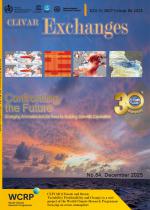The El Niño–Southern Oscillation (ENSO) phenomenon is a naturally occurring climate fluctuation, which originates in the tropical Pacific region and affects ecosystems, agriculture, freshwater supplies, hurricanes and other severe weather events worldwide (Goddard and Dilley 2005; McPhaden et al. 2006). Despite considerable progress in our understanding of the impact of climate change on many of the processes that contribute to ENSO variability (e.g., Collins et al. 2010), it is not yet possible to say whether ENSO activity will be enhanced or damped, or if the frequency or character of events will change in the coming decades (Vecchi and Wittenberg 2010). As changes in ENSO have the potential to be one of the largest manifestations of anthropogenic climate change, this status has profound impacts on the reliability of regional attribution of climate variability and change. Two main reasons can be invoked for these shortcomings. First there is a lack of long and comprehensive enough observations of the various ENSO processes to be able to detect past changes. It may be that we need to observe ENSO for another several decades to detect and attribute significant ENSO changes (Wittenberg 2009; Stevenson et al. 2012). Second, as ENSO involves a complex interplay of numerous ocean and atmospheric processes, accurately modeling this climate phenomenon with CGCMs, and understanding, anticipating, and predicting its behaviour on seasonal to decadal and longer time scales still pose formidable challenges (Guilyardi et al. 2009). Even though the ability of CGCMs to simulate El Niño has largely improved over the last few years, the diversity of model simulations of present-day El Niño characteristics indicate current limitations in our ability to model this climate phenomenon and anticipate changes in its properties on short and long time scales. In this context, there is a pressing need to assess how can we use models to anticipate potential changes to ENSO in a warmer climate.
ENSO in a changing climate
About Us
Terms Of Reference
- Better understand the role of different physical processes that influence ENSO characteristics and the diversity of El Niño events on decadal time scales.
- Provide a synthesis of existing ENSO evaluation methods in GCMs.
- Propose ENSO evaluation protocols and develop a strategy for coordinated ENSO analysis of CMIP models, including development and maintenance of an interactive website, in coordination with the WGCM Metrics Panel.
- Propose ENSO specific simulations for consideration by CMIP6 (“ENSOMIP”).
- Promote community best practice in ENSO evaluation and understanding in GCMs
- Identify new observations needed to better constrain ENSO processes, both for the current climate and for past climates (via paleo proxies and TPOS).
- Provide a better understanding of how ENSO might change in the future.
News View
Publications and Documents
Members
| Title | Role | Year | Institute | Country |
|---|---|---|---|---|
| Eric Guilyardi | Co-Chair | IPSL | France | |
| Andrew Wittenberg | Co-Chair | GFDL | USA | |
| Wenju Cai | Member | CSIRO | Australia | |
| Mat Collins | Member | University of Exeter | UK | |
| Ben Kirtman | Member | RSMAS | USA | |
| Mike McPhaden | Member | PMEL | USA | |
| Tony Lee | Member | JPL | USA | |
| Soon-Il An | Member | Yonsei University | Rep Korea | |
| Pascale Braconnot | Member | IPSL | France | |
| Lisa Goddard | Member | IRI | USA | |
| Jaci Brown | Member | CSIRO | Australia | |
| Masahiro Watanabe | Member | University of Tokyo | Japan |
The ICPO contact for the CLIVAR Research Foci "ENSO in a changing climate" is Jing Li.










